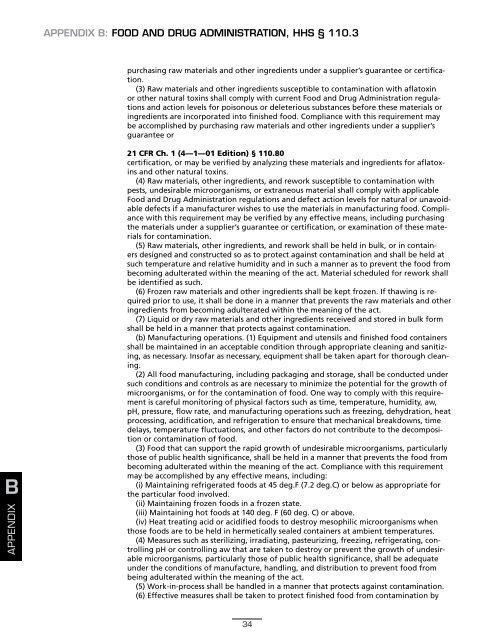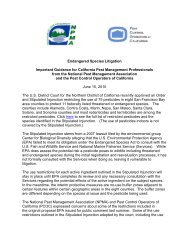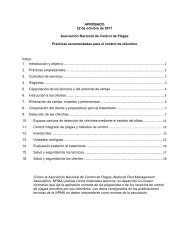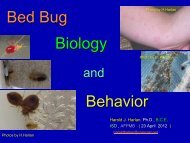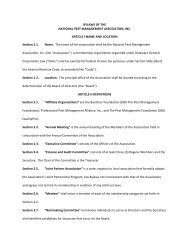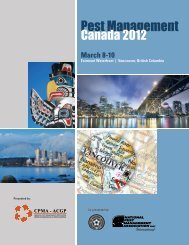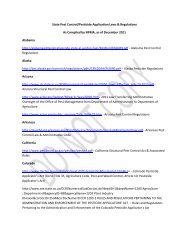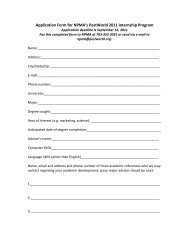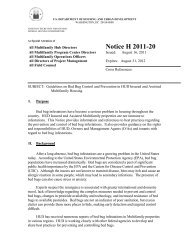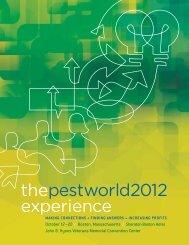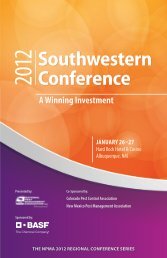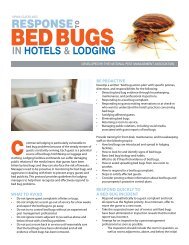Pest Management Standards For Food Plants - National Pest ...
Pest Management Standards For Food Plants - National Pest ...
Pest Management Standards For Food Plants - National Pest ...
You also want an ePaper? Increase the reach of your titles
YUMPU automatically turns print PDFs into web optimized ePapers that Google loves.
Appendix B: <strong>Food</strong> and Drug Administration, HHS § 110.3<br />
purchasing raw materials and other ingredients under a supplier’s guarantee or certification.<br />
(3) Raw materials and other ingredients susceptible to contamination with aflatoxin<br />
or other natural toxins shall comply with current <strong>Food</strong> and Drug Administration regulations<br />
and action levels for poisonous or deleterious substances before these materials or<br />
ingredients are incorporated into finished food. Compliance with this requirement may<br />
be accomplished by purchasing raw materials and other ingredients under a supplier’s<br />
guarantee or<br />
B<br />
APPENDIX<br />
21 CFR Ch. 1 (4—1—01 Edition) § 110.80<br />
certification, or may be verified by analyzing these materials and ingredients for aflatoxins<br />
and other natural toxins.<br />
(4) Raw materials, other ingredients, and rework susceptible to contamination with<br />
pests, undesirable microorganisms, or extraneous material shall comply with applicable<br />
<strong>Food</strong> and Drug Administration regulations and defect action levels for natural or unavoidable<br />
defects if a manufacturer wishes to use the materials in manufacturing food. Compliance<br />
with this requirement may be verified by any effective means, including purchasing<br />
the materials under a supplier’s guarantee or certification, or examination of these materials<br />
for contamination.<br />
(5) Raw materials, other ingredients, and rework shall be held in bulk, or in containers<br />
designed and constructed so as to protect against contamination and shall be held at<br />
such temperature and relative humidity and in such a manner as to prevent the food from<br />
becoming adulterated within the meaning of the act. Material scheduled for rework shall<br />
be identified as such.<br />
(6) Frozen raw materials and other ingredients shall be kept frozen. If thawing is required<br />
prior to use, it shall be done in a manner that prevents the raw materials and other<br />
ingredients from becoming adulterated within the meaning of the act.<br />
(7) Liquid or dry raw materials and other ingredients received and stored in bulk form<br />
shall be held in a manner that protects against contamination.<br />
(b) Manufacturing operations. (1) Equipment and utensils and finished food containers<br />
shall be maintained in an acceptable condition through appropriate cleaning and sanitizing,<br />
as necessary. Insofar as necessary, equipment shall be taken apart for thorough cleaning.<br />
(2) All food manufacturing, including packaging and storage, shall be conducted under<br />
such conditions and controls as are necessary to minimize the potential for the growth of<br />
microorganisms, or for the contamination of food. One way to comply with this requirement<br />
is careful monitoring of physical factors such as time, temperature, humidity, aw,<br />
pH, pressure, flow rate, and manufacturing operations such as freezing, dehydration, heat<br />
processing, acidification, and refrigeration to ensure that mechanical breakdowns, time<br />
delays, temperature fluctuations, and other factors do not contribute to the decomposition<br />
or contamination of food.<br />
(3) <strong>Food</strong> that can support the rapid growth of undesirable microorganisms, particularly<br />
those of public health significance, shall be held in a manner that prevents the food from<br />
becoming adulterated within the meaning of the act. Compliance with this requirement<br />
may be accomplished by any effective means, including:<br />
(i) Maintaining refrigerated foods at 45 deg.F (7.2 deg.C) or below as appropriate for<br />
the particular food involved.<br />
(ii) Maintaining frozen foods in a frozen state.<br />
(iii) Maintaining hot foods at 140 deg. F (60 deg. C) or above.<br />
(iv) Heat treating acid or acidified foods to destroy mesophilic microorganisms when<br />
those foods are to be held in hermetically sealed containers at ambient temperatures.<br />
(4) Measures such as sterilizing, irradiating, pasteurizing, freezing, refrigerating, controlling<br />
pH or controlling aw that are taken to destroy or prevent the growth of undesirable<br />
microorganisms, particularly those of public health significance, shall be adequate<br />
under the conditions of manufacture, handling, and distribution to prevent food from<br />
being adulterated within the meaning of the act.<br />
(5) Work-in-process shall be handled in a manner that protects against contamination.<br />
(6) Effective measures shall be taken to protect finished food from contamination by<br />
34


